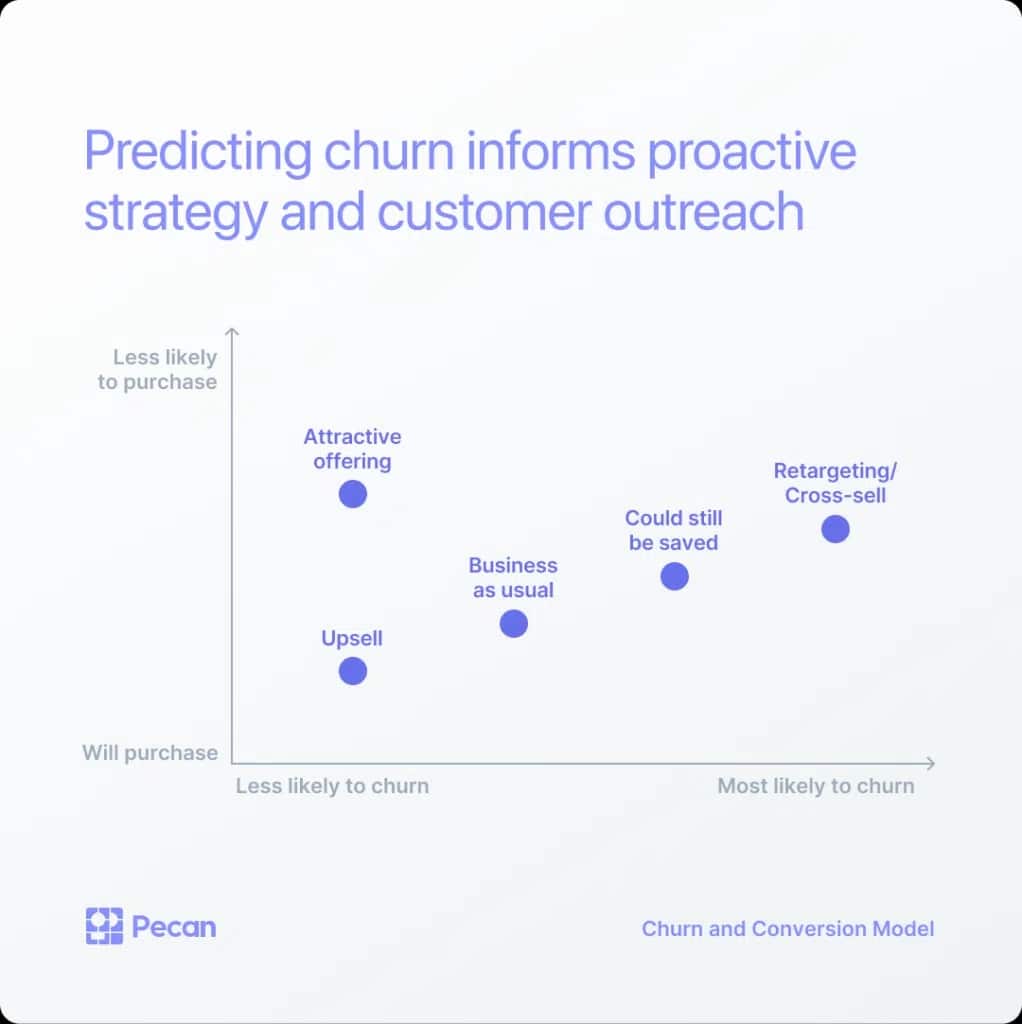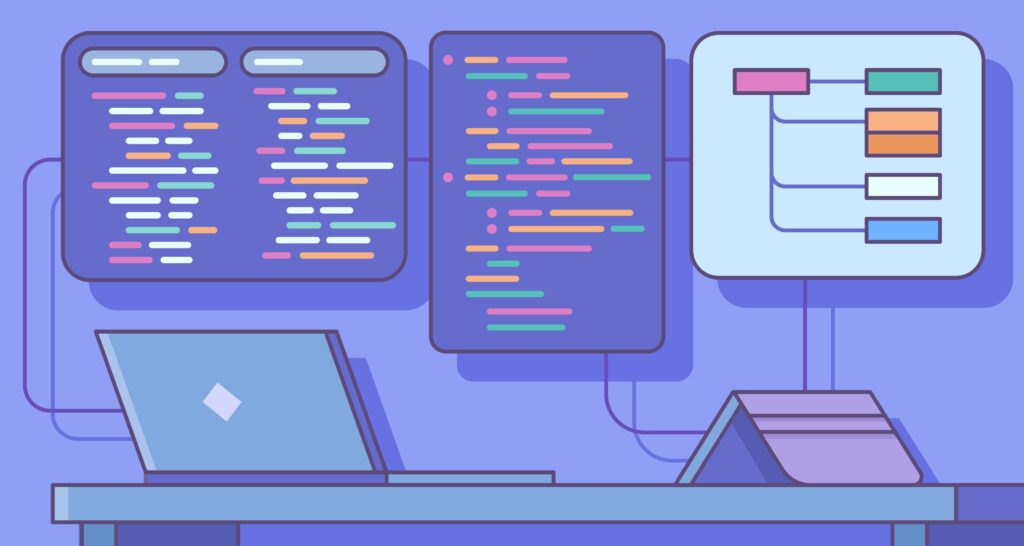In a nutshell:
- Predictive modeling combines AI and historical data to make accurate predictions for businesses.
- It involves defining the problem, preparing data, building models, and integrating findings into workflows.
- Common types of predictive models include classification, regression, clustering, and anomaly detection.
- Algorithms like random forest and linear regression are used to generate predictions.
- Predictive modeling can be used for marketing mix modeling, customer churn prediction, and supply chain demand forecasting.
In the modern data-driven business environment, staying one step ahead of your competitors can make all the difference. Forecasting sales, predicting supply chain issues, and trying to anticipate customer churn are no longer enough. Every business is doing the same thing.
So, how do you stand apart? Well, it’s not the quantity of predictions your business makes but the quality that matters, and whether you can take efficient action on them. By leveraging predictive analytics, companies can combine something they’ve always used (like historical data) with new technologies (AI and machine learning models) to make faster and significantly more accurate predictions than ever before.
The result? These companies can maximize revenue, reduce costs, and streamline operations to the point where they leave any competitor not leveraging this technology far behind.
In this article, we’ll explore the fundamentals of predictive modeling, its benefits to your business, and the specific use cases that make predictive modeling so powerful.
What is predictive modeling?
Predictive modeling (also known as predictive analytics) is a mathematical technique that combines AI and machine learning with historical data to predict future outcomes accurately. These calculations happen almost instantaneously, allowing businesses to use predictions to make decisions in real time.
For example, a business can predict the likelihood of future customers spending a certain amount over a given period based on billions of data points from all current and previous customer interactions. But you can use predictive modeling to predict just about anything.
The important thing to remember is that these outcomes are not fixed. Predictive models are regularly revised based on new and changing data. If you change your customer success strategy, the likelihood of customer churn, as calculated by a predictive model, will hopefully decrease.
As you may have guessed, predictive modeling can be incredibly powerful and help businesses to make smarter, more profitable decisions. No wonder, then, that the global predictive analytics market is expected to reach $67.66 billion by 2030, up from $14.71 billion in 2023.
How does predictive modeling work?
The predictive modeling process has three core elements: the datasets, the predictive model, and the algorithm used to make predictions. From there, it’s a five-step process to predictive analytics success:
A typical predictive analytics workflow
Start by defining the exact problem you want predictive modeling to solve. The more specific and well-defined your goal, the easier it will be to implement a predictive model to achieve it.
Second, find as many suitable and high-quality data sources as possible. Then, prepare that data. Every dataset will likely have to be cleaned to make it useful during the modeling process. (Unless, of course, you’re using a platform like Pecan that can handle much of this data preparation process for you.)
The penultimate step is building and evaluating models. This can be done from scratch or using a low-code predictive analytics platform.
Finally, you’ll need a strategy to integrate your findings from predictive analytics into your workflows. There’s no point in working so hard to source data sets and build models if you aren’t going to use the data to transform business processes, is there?
Types of predictive models
You don’t need to create a new model for every prediction you want to create. Predictive modeling platforms like Pecan will use one of several models to make forecasts.
The most common types of predictive models are:
- Classification model: Classifies historical data into different categories. It can be used to predict a two-class outcome (such as whether a lead converts or not) or a multi-class outcome (such as whether an email is promotional, personal, important, or spam).
- Regression model: Uses historical data to predict a continuous variable like customer lifetime value.
- Clustering model: Groups data by common attributes to predict the future behavior of a specific item or individual. For example, whether a potential new market area fits the attributes of previously successful market areas.
- Forecast model: A model that estimates a future figure based on historical data, like how many products a store should order next month, for example.
- Time series model: Uses historical data from a given period as well as other related data sets to predict an outcome over a future given period — for example, sales over the next six months.
- Anomaly detection model: Predicts whether a behavior or data point is abnormal or considered an outlier. It can be used to predict whether a purchase is fraudulent.
Algorithms for predictive models
Predictive models use a machine learning algorithm to generate predictions. Some of the most common algorithms include:
Random forest predictive modeling: A combination of decision trees that each make their own prediction, performing both classification and regression.
Gradient boosted predictive model: A technique that employs a series of related decision trees to generate a prediction.
Linear regression: One of the simpler machine learning techniques that simulates the relationship between independent factors and a numerical target response.
Logistic regression: A regression model that captures the association among several variables; best suited for scenarios where the target variable has two potential outcomes.
The benefit of predictive analytics
Predictive modeling offers several advantages over traditional forecasting techniques.
First, it is far quicker and easier to generate predictive modeling predictions. A predictive analytics platform can now handle much of the low-level manual work associated with making these kinds of predictions. In many cases, these predictions can be generated frequently based on automated data collection and analysis to guide decisions with the most recent information.
Predictive models are also tailored to your business. Because the predictions these models generate are based on your company’s proprietary data, they will be much more meaningful and actionable.
3 business use cases for predictive models
Several departments across multiple industries actively use predictive modeling to make customer and business-focused predictions and decisions.
Marketing mix modeling
Predictive modeling can help you better allocate marketing resources across channels to improve your campaigns' impact and ROI. Marketing mix modeling (MMM) has been used for years, but MMM guided by AI and machine learning can generate deeper understanding and actionable information faster.
Use it to predict the performance of each channel so you can know which channels will drive the highest revenue and allocate budget accordingly. Take things further by simulating and testing what-if scenarios so you can know how much to spend to generate the highest possible ROAS.
Pecan's marketing mix modeling provides insights into marketing ROI.
Case in point, a Pecan AI client using MMM identified over $100 million in overspending and generated over $200 million in potential savings.
Predicting and reducing customer churn
Whatever churn looks like for your business, start getting ahead of your customers by using predictive modeling to intervene quickly. With predictive modeling, success teams can predict churn before it happens and take a proactive approach to retention — increasing customer numbers and boosting lifetime value.
Customer success teams can use predictive modeling to prioritize their efforts, allowing budget and resources to be spent as efficiently as possible. You can take things further by using granular details and predictions to personalize prevention-focused customer outreach. Save resources and increase effectiveness by choosing the right customer retention treatments every time.
Predictive modeling for churn enables proactive responses to retain customers.
One Pecan client, for example, used churn-focused predictions to highlight the players who most needed a nudge to return to the game. This allowed them to better target their ads and use their budget. They rolled out this strategy across seven mobile games, saving millions annually.
Supply chain demand forecasting
You can optimize dozens of business processes if you can predict how your customers will behave in the future. Predictive modeling can provide advance knowledge of consumer demand, allowing you to estimate sales, orders, and shipments. You can even predict demand at a granular level, whether by store, SKU, or something else. Then, get to the heart of the financials by predicting how future consumer behavior will impact your business’s cash flow.
Using these techniques, one Pecan AI customer cut overstock by 50%, thanks to a prediction precision rate of 80-95%.
Common predictive modeling challenges
Predictive modeling isn’t quite the panacea you may be envisioning. While numerous upsides exist, your team may need to overcome a couple of predictive modeling challenges.
A shortage of data
The first is a need for more high-quality data. Successful predictions rely on access to a huge amount of clean and accurate data. That kind of data, until recently, was hard to come by for all but the biggest companies.
With the emergence of technology platforms like CRMs, ERPs, and other business applications, this data is much more accessible for companies of every size. This challenge can be easily resolved by working with a predictive analytics platform that offers integrations with other tools in your tech stack.
Inaccurate or out-of-date data
The more data, the better the prediction. But only accurate data will do. Predictive models are only effective if they use an up-to-date, readily available data source. One reason companies adopting predictive modeling techniques need to have a process for collecting as much data as possible is that they must also work with a predictive analytics platform that has in-built integrations to major databases and data warehouses.
Processing and cleansing data is time-consuming
Predictive modeling requires significant data preprocessing (think cleansing and normalization) — a task that can be incredibly time-consuming and prone to errors when done manually.
The solution is to use a predictive modeling platform that automates many of these processes, speeding them up and reducing the risk of errors.
Automating the predictive modeling process
Rather than a team of data scientists to prep the data, it takes just one data professional to build, deploy, and analyze predictive models.
Identifying suitable business use cases
Predictive modeling can be applied to many use cases. However, adopting it without a specific goal or department in mind can lead to confusion, frustration, and, ultimately, a waste of resources. When choosing a predictive modeling platform, first identify your business need and then choose a platform that solves your specific problem.
Choosing a predictive analytics platform
In the past, building, integrating, and leveraging predictive models would have required bespoke and complex code written every time you launched a new application. Today, predictive analytics platforms provide a low-code way to quickly build accurate models for almost any application.
While these tools reduce risk and accelerate the predictive modeling process, knowing where to start isn’t always easy.
Different tools have different data requirements and serve different purposes. That makes it important to identify a core business challenge you want to solve or a goal you want to achieve and the data sets available before selecting a platform.
Make sure you are clear on who is responsible for setting up the platform, deploying the models, and analyzing the data. Is it your IT or data team, for instance? Or is it the responsibility of individual departments?
Get started with predictive modeling today
Ready to generate more in-depth, faster, and more accurate predictions and in-depth knowledge of your business? Predictive modeling can improve decision-making across almost every business function — and an easy-to-use predictive analytics platform makes things even easier.
Improve customer acquisition, customer engagement, and supply chain practices with Pecan’s predictive modeling. Start your free trial today. Or, if you’d prefer, we can give you a guided tour.









